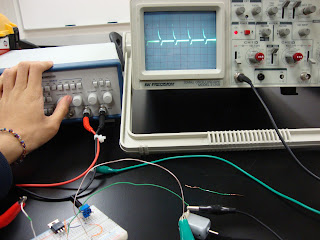Capacitor Charging/ Discharging
Purpose
To examine the charging and discharging of a capacitor circuit using thevenin equivalences.
We have to circuits, one for charging and one for discharging.
The goal is to design build and test a circuit that does the following:
1.utilizes a 9V power
2. Employs a charging interval of 20s with a stored energy of 2.5mJ
3. discharges the 2.5mJ in 2s
To fulfill these requirements we have the following for charging resistance and capacitance
The peak current, discharge and resistance were then determined.
the actual values used were.
the circuit was the built.
logger pro was then used to record the results
Data:
Charging Curve.
The capacitor saturates at around 8.5V due to its internal resistance.
Discharge curve.
Its not done completely in 2 secs but it is close.
he charging and discharging of capacitors is exponential and the time to make them discharge and charge can be easily controlled by changing the value of the resistance and/or capacitors.





















